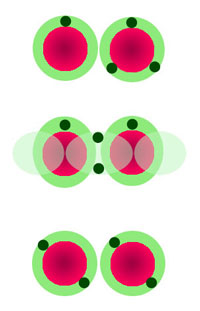| Posted: July 25, 2008 |
Nuclear chemistry |
|
(Nanowerk News) An atomic nucleus can sometimes look like a kind of molecule – a pair of particle clumps bound together like a pair of atoms, except that neutrons take the place of electrons as the "glue." In the May 9 Physical Review Letters ("Coexistence of Covalent Superdeformation and Molecular Resonances in an Unbound Region of 12Be") and the July Physical Review C ("Covalent isomeric state in 12Be induced by two-neutron transfers"), Japanese theorists show that a single beryllium nucleus can briefly resemble a covalently bonded molecule, an ionically bonded molecule, or just a pair of neutral atoms. It all depends on the energy with which two smaller nuclei collide to create the beryllium nucleus. The results underscore the importance of clumps of neutrons and protons within nuclei.
|
 |
| The Structure Within. Depending on the energy with which two helium nuclei collide, extra neutrons (dark green) within them can act like electrons in a molecule to bind the alpha-particle cores (red) in an "ionic" (top), "covalent" (center), or "atomic" configuration. A new theory predicts details of these states, which have never been seen in a single nucleus before. (Adapted from M. Ito/RIKEN)
|
|
The alpha particle, containing two protons and two neutrons, plays a special role in the structure of nuclei. This tightly bound quartet emerges during radioactive decay of nuclei like uranium-238, and is itself the nucleus of the common isotope of helium. When two helium nuclei containing extra neutrons collide, the alpha particles may each remain intact, while the extra neutrons act like the electrons in a hydrogen molecule and create a "chemical bond" to briefly hold the two alpha particles together. Experimenters have previously seen such a state for the beryllium-9 nucleus, which behaves like a pair of alpha particles covalently bonded with a shared extra neutron. But an unstable covalent state could be probed more directly, by tuning the energy of the colliding nuclei to match it.
|
|
Makoto Ito, of the RIKEN Nishina Center for Accelerator-Based Science in Saitama, Japan, and his colleagues calculated possible structures for the unstable beryllium-12 nucleus, which contains four extra neutrons in addition to two alpha particles. Depending on how much internal energy the nucleus has, it can resemble two "neutral atoms" with two neutrons on each alpha particle, or a pair of "ions" with one or two neutrons transferred from one to the other, or a "covalently bonded" pair in which two neutrons are shared between the two. Although each of these configurations has been discussed previously, Ito says, his article in Physical Review Letters is "the first study to describe the formation of both the covalent and ionic bonds of excess neutrons in a single nucleus." It would also be the first unstable example of a covalent state.
|
|
In the Physical Review C article, Ito and Naoyuki Itagaki of the University of Tokyo apply these calculations to a specific experiment: the collision between an ordinary helium-4 nucleus (an alpha particle) and a helium-8 nucleus, which has four extra neutrons. They predict that, if the two nuclei approach with energy that matches one of three specific values, the resulting beryllium-12 nucleus can adopt one of these three structures for a relatively long time--about 10-21 seconds. If one of these intermediate states forms, experimenters are more likely to find that two helium nuclei that emerge from the collision have two extra neutrons each, instead of the zero and four they started with – a process called neutron transfer. Ito and Itagaki calculated the probability for this process.
|
|
Researchers have looked for enhanced neutron transfer for decades, says experimentalist Martin Freer of the University of Birmingham in England. "It's still at the limits of what's possible," he says, but with some luck and good experimental design, "it might be possible to see such effects." Beams of radioactive ions like helium-8, with just enough energy to form these transient states have only recently become available at the GANIL facility in Caen, France. In fact, Freer says that he and his colleagues have already done the experiment of firing these beams into ordinary helium, but that they are still analyzing the results.
|
|
|

